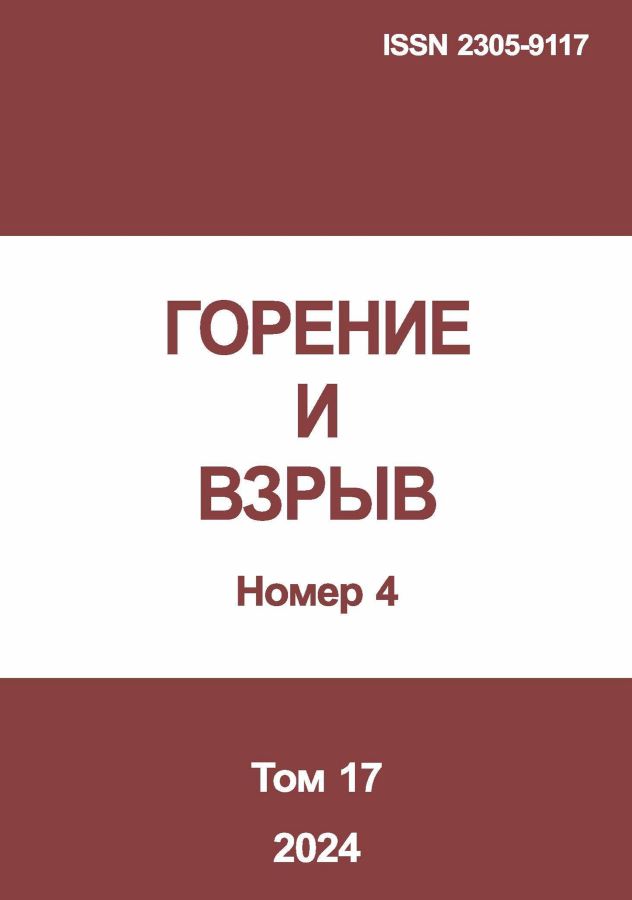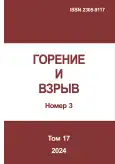On the dependence of surface temperature on the burning rate of HMX
- Authors: Marshakov V.N.1, Melik-Gaikazov G.V.1
-
Affiliations:
- N. N. Semenov Federal Research Center for Chemical Physics of the Russian Academy of Sciences
- Issue: Vol 17, No 3 (2024)
- Pages: 92-100
- Section: Articles
- URL: https://journal-vniispk.ru/2305-9117/article/view/277576
- DOI: https://doi.org/10.30826/CE24170309
- EDN: https://elibrary.ru/EKTWDS
- ID: 277576
Cite item
Abstract
The paper presents the results of processing the experimental data available in the literature on the surface temperature and burning rate of double-base propellants, RDX and HMX. The interrelation between the burning rate and surface temperature for them is represented in the form of a single, unambiguous, and unified correlation independent of the initial temperature of the sample. For HMX, such a correlation takes a form (SD = 0.06) or U = 124exp(−2550/Ts) where [U] = cm/s and [Ts] = °C and, conversely, Ts = 516 + 72lnU (SD = 7.2) valid for the ranges of burning rates 0.05 < U < 1.0 cm/s and surface temperatures 360 < Ts < 515°C. The derived correlations U(Ts) allow estimation of the temperature at individual points on the front of the transverse wave based on the local values of the burning rate in these points.
Full Text
About the authors
Vladimir N. Marshakov
N. N. Semenov Federal Research Center for Chemical Physics of the Russian Academy of Sciences
Author for correspondence.
Email: marsh_35@mail.ru
Doctor of Sciences in Physics and Mathematics, Chief Researcher
Russian Federation, MoscowGeorgy V. Melik-Gaikazov
N. N. Semenov Federal Research Center for Chemical Physics of the Russian Academy of Sciences
Email: marsh@chph.ras.ru
Candidate of Sciences in Physics and Mathematics, Engineer
Russian Federation, MoscowReferences
- Zenin, A. A., and B. V. Novozhilov. 1973. Single-valued dependence of the surface temperature of ballistite on the burning rate. Combust. Explo. Shock Waves 9(2):209–212. doi: 10.1007/BF00814816.
- Zenin, А. А. 1962. Izuchenie raspredeleniy temperatury pri gorenii kondensirovannykh veshchestv [Study of temperature distributions in combustion of condensed substances]. Moscow: IChF AN SSSR. PhD Diss. 213 p.
- Zenin, А. А. 1966. Structure of temperature distribution in steady-state burning of a ballistite powder. Combust. Explo. Shock Waves 2(3):40–45. doi: 10.1007/BF00749025.
- Zenin, A. A., O. I. Leipunsky, A. D. Margolin, O. I. Nefedova, and P. F. Pokhil. 1966. Pole temperatur u poverkhnosti goryashchego porokha i ustoychivost’ goreniya [Temperature field at the surface of a burning propellant and combustion stability]. Dokl. Akad. Nauk SSSR 169(3):619–622.
- Zel’dovich, Ya. B., O. I. Leipunsky, and V. B. Librovich. 1975. Teoriya nestatsionarnogo goreniya porokha [Theory of unsteady combustion of gunpowder]. Moscow: Nauka. 133 p.
- Zenin, А. А., and O. I. Nefedova. 1967. Burning of ballistite powder over a broad range of initial temperatures. Combust. Explo. Shock. Waves 3(1):26–31. doi: 10.1007/ BF00741607.
- Zenin, А. А. 1980. Protsessy v zonakh goreniya ballistitnykh porokhov [Processes in the combustion zones of ballistic powders]. Fizicheskie protsessy pri gorenii i vzryve [Physical processes during combustion and explosion]. Moscow: Atomizdat. 68.
- Denisyuk, A. P., and U Zo Twe. 2011. K voprosu ob odnoznachnoy zavisimosti skorosti goreniya porokhov ot temperatury poverkhnosti [On the question of the unambiguous dependence of the burning rate of powders on the surface combustion temperature]. Goren. Vzryv (Mosk.) — Combustion and Explosion 4:214–219.
- Puchkov, V. M. 1978. Struktura zon goreniya TRT v statsionarnykh rezhimakh i pri pogasanii [The structure of the combustion zones of TRT in the stationary modes and with the extinction]. Moscow: IChF AN SSSR. PhD Diss. 211 p.
- Zenin, A. A., V. M. Puchkov, and S. V. Finyakov. 1998. Characteristics of HMX combustion waves at various pressures and initial temperatures. Combust. Explo. Shock Waves 34(2):170–176.
- Zenin, A., and S. Finjakov. 2006. Characteristics of octogen and hexogen combustion: A comparison. 37th Annual Conference (International) of ICT. Karlsruhe. Paper 118. 18 p.
- Zenin, A. A., and S. V. Finjakov. 2007. Response functions of HMX and RDX burning rates with allowance for melting. Combust. Explo. Shock Waves 43(3):309–319. doi: 10.1007/s10573-007-0044-z.
- Zenin, A. А., and S. V. Finjakov. 2009. Studying RDX and HMX combustion mechanisms by various experimental techniques. Combust. Explo. Shock Waves 45(5):559–578. doi: 10.1007/s10573-009-0068-7.
- Zenin, A. A., and S. V. Finjakov. 2013. Nonlinear response functions of the burning rate of RDX and HMX. Combust. Explo. Shock Wave 49:593–607.
- Marshakov, V. N., and G. V. Melik-Gaizakov. 2021. Lokal’nye skorosti fronta ochagov goreniya oktogena [Local velocities for octogen of hot-spot combustion front in HMX]. Goren. Vzryv (Mosk.) — Combustion and Explosion 14(1):59–67. doi: 10.30826/CE21140107.
- Marshakov, V. N., and V. G. Krupkin. 2023. Hotspot combustion of HMX. Russ. J. Phys. Chem. B17(2):394–398. doi: 10.31857/S0207401X2303010X. EDN: NBCKRZ.
- Maksimov, E. I., and A. G. Merzhanov. 1966. Theory of combustion of condensed substances. Combust. Explo. Shock Waves 2(1):25–31. doi: 10.1007/BF00750592.
- Ermolin, N. E., and V. E. Zarko. 1998. Modeling of cyclicnitramine combustion. Combust. Explo. Shock Waves 34(5):485–501. doi: 10.1007/BF02672671.
- Sinditskii, V. P., V. Yu. Egorshev, M. V. Berezin, and V. V. Serushkin. 2009. Mechanism of HMX combustion in a wide range of pressures. Combust. Explo. Shock Waves 45(4):461–477.
Supplementary files














